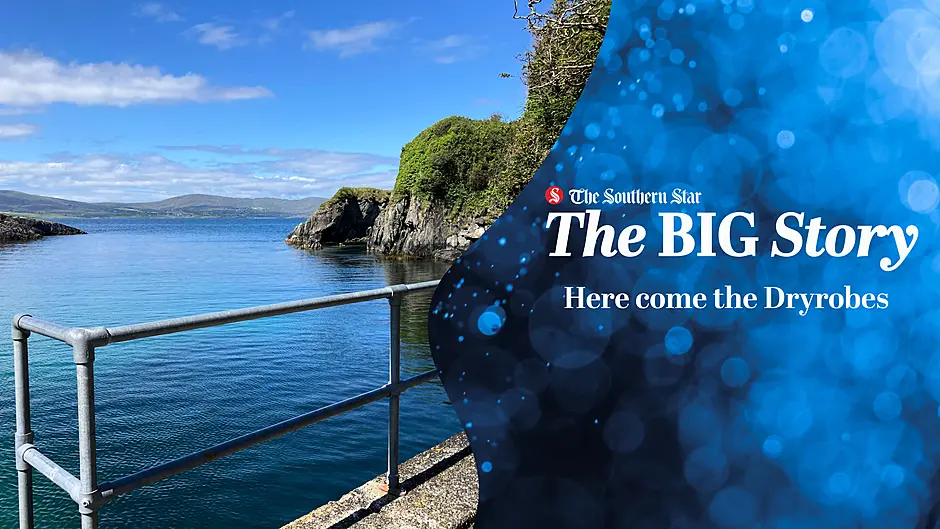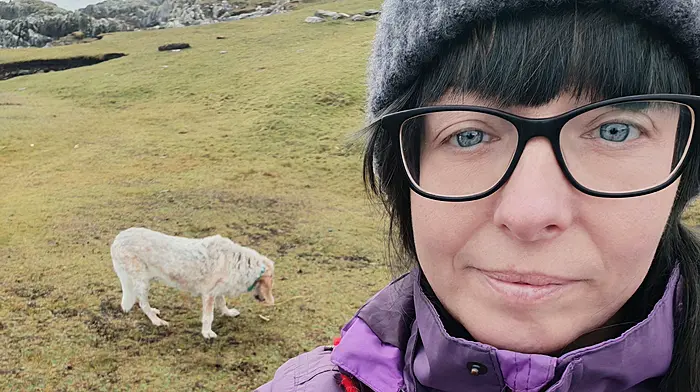Listen
--
Irish people taking to the sea in their droves has become a bit of a cliché during the pandemic.
But the truth is, for some of us, it was never a fad – it was just a part of life.
Whether it’s used as a tool for socialising, exercising or reasons related to the reported mental health benefits - open water swimming has fast become a pastime for everyone - not just the endurance athletes training to swim the channel!
--
Here come the Dryrobes is the sixth episode of a digital first series from The Southern Star.
The Big Story, which is exclusive to The Southern Star’s digital platforms, brings readers closer to West Cork’s most important topics.
Episode six is written and produced by Southern Star editor Siobhan Cronin and Southern Star digital manager Jack McCarron. Video production is by Seamus Ó Suilleabháin of www.birinbeo.com.
The Big Read to accompany this piece, written by Siobhan Cronin is available by scrolling down this page.
The Big Story is available on southernstar.ie, Youtube and all the major podcasting platforms, including Apple Podcasts and Spotify.
--
Read
By Siobhan Cronin
Irish people taking to the sea in droves has become a bit of a cliché during the pandemic but the truth is, for some of us, it was never a fad – it was just a part of life.
I have loved the sea forever. With a mum from Malin Head in Donegal, a father from Cobh, and me being born right in the middle, near the west coast of Clare, I guess the Atlantic was always going to figure in my life.
Like most people, I learned to swim – badly – during my summer holidays.
And in winter, there were always the regular visits to the pool after school.
It was no big deal, just something we did for fun.
But, for me, all that changed in 2001.
After an operation for a slipped disc, my surgeon told me swimming would be the best way to strengthen my back muscles.
So, what started out as a necessary evil – I was never keen on exercise – quickly became an addiction.
I got a personal coach who gave me swimming drills in the pool to practise, up and down, up and down, up and down.
But it was only when I moved from the city to West Cork that I realised the huge resource that was no on my doorstep – the sea.
Most people can’t explain the lure of the open water – they just feel it.
Dee Cunningham is a swim coach with Swim Ireland.
This summer she spent her Friday mornings at the pretty little beach at Tragumna in West Cork, with her beginner’s class, followed by an improver’s class for more experienced swimmers.
Coming down from the city, she said West Cork people should be very appreciative of the magnificent natural resources so close to them.
Standing on the beach in front of the island, and pointing out that Lough Hyne is yet another brilliant swimming location just a short distance along the coast, Dee explains the sudden surge in interest in the activity.
‘A lot of people are getting into open water swimming and beginning to really enjoy it. They are creating a little community with one another. They are making huge bonds, and friendships for life, really.’
She says it’s really improving people’s physical and mental health.
‘Like anything, it’s a new skill, and it takes time to get a new skill up to speed. As we get older, we all have our own set ways, so it’s important to peel back the onion, and go back to basics when you are learning.’
She says the community of swimming explains a lot about its popularity now, especially in the pandemic. ‘That’s what people really want, isn’t it? To belong. And that is what swimming can give you – being part of that community.’
‘For me, and from what I am hearing from other people, they are getting down to the elements, seeing the beautiful wildlife under the sea.’
She says she loves to swim through the kelp seaweed under the surface which she describes as the ‘grass of the sea’.
And she adds we must always be respectful of the creatures below. ‘We are visitors to their world, after all.’
Safety is, of course, paramount, she says. You must always go in groups, tell people where you are going and when you expect to be back, bring a tow float (for visibility and for resting) and wear a bright hat so you can be easily seen, too.
Hydrate before you go out and have a hot drink ready for when you come back.
When swimming in cold water, swimmers quickly learn that while the body will adjust easily to the temperature during a swim, they need to dress immediately after coming out, as the body’s core temperature will drop rapidly and that is when hypothermia can set in.
Always bring more clothes for after your swim than you needed beforehand, and a woolly hat is a must-have accessory, too.
Dee says that while safety must always be to the fore of any swim, the mental health benefits will come automatically.
‘It is just so good for your mental health, anyone who swims regularly will tell you that. And enjoy it? That you will do, it goes without saying.’
Another regular swimmer is Maeve Kingston who lives near Skibbereen.
The 5th year student says she started swimming during the pandemic and never looked back.
Having struggled a bit with her own mental health, her mother convinced her to get into the water and she soon discovered she loved it.
‘Now I can’t do without it, I feel I need to swim every day,’ she says.
With some very difficult months experienced by our teenagers over the past year, Maeve said she wanted to encourage other young people to take the plunge, too.
‘We have been through a lot but I would love other people my age to try out swimming. It’s been amazing and I think it should be part of the school day, especially in West Cork here, where we have so many great beaches.’
But it’s not just a feeling that it’s good for us, c, quite a lot of research has been conducted into it.
Ever heard of the Blue Mind? Well, the phrase was coined by Californian biologist Wallace J Nichols, who has written a book of the same name.
He believes most of us live in a state of constant stress because of the frantic pace of modern life – he calls this the ‘red mind’.
The colour blue has a scientifically proven calming effect. He says some medics have even discovered its use in intricate surgery.
‘The ocean reminds us we are small,’ he said in a 2012 TedX talk, and so being in it helps to relieve that stress.
His research has shown that our bodies react positively to the experience of water, from listening to a trickling fountain. To standing underneath a strong shower right up to throwing ourselves feet-first into a raging sea.
Salt is a very important component of our world. When added to water, it breaks apart into individual freely moving particles called ‘ions’.
These ions carry an electrical charge, and it seems these tiny electrical charges have a positive effect on bodies.
Some people have noticed the benefits of just being immersed in salt water – just standing there, not even moving. It has been used as a treatment for muscle problems, depression, and anxiety.
These days, some surgeons are even prescribing to post-surgery patients a 30-minute daily dip in salt water, as the mainstay of their rehabilitation regime.
You don’t have to swim in it – but when you do, you are then getting the full treatment of health benefits because it uses such a wide variety of muscle groups.
It is also low impact, meaning it’s perfect for so many people – like myself – who suffer from back problems. I was warned off running, or even long walks, because of their impact on the spine, and so swimming is the ultimate gentle rehabilitation programme.
Lifeguard Eoghan O’Donnell from Kinsale, who has been working on beaches in West Cork this summer, says the beach guards have all noticed more of the ‘Orca men and women’ around, as he calls them – referring to the most popular brand of wetsuit for open water swimming.
He says the most important thing to know, as a swimmer, is your strengths and weaknesses, so you can assess your limits.
He repeats Dee’s advice that you should never go alone, and always inform people when you are heading out, even in a group.
Always wear a wetsuit so the cold is not going to be an issue, especially when you are a learner, and, very importantly, he says, ‘know your beach’.
You want to know where the hazards are, where there may be rip currents, and also if there are any jellyfish about!
So what Eoghan is referring to here, really, are the gentle sea swimmers, the ones that just want to build up to, say, a 2km regular swim.
That should take under an hour for a relatively smooth swimmer and anything beyond that would really require a high level of skill, and good equipment.
Two men who know all about ‘elite’ swimming are expert swimmers Noel Browne and ‘Oceans 7’ swimmer Steve Redmond.
They both agree that West Cork is a brilliant location for those adventure swimmers – the elite crew – who need to keep challenging themselves.
Steve Redmond, originally from the landlocked county of Carlow, became a serious swimmer when he realised the amazing training ground that was within arm’s reach, when he moved to Ballydehob.
Now, along with his training buddy Noel Browne, he wants to share that brilliant resource with other accomplished swimmers who, like themselves, want to keep pushing the limits and have their eyes on ‘landmark’ swims to tick off a list.
Noel says he caught the bug after watching the ‘lunatic’ Redmond swimming around in his togs in winter in Lough Hyne, and he decided to give it a go. ‘It started to progress from there and I don’t think my addiction is ever going to be cured at this stage, but it’s led to some brilliant times and brilliant people.’
He says that once you get into the water, your head has to concentrate on what’s in front of you, and you have to let the rest of your life take a back seat for a while. ‘So many people got into it in the last year in particular, it’s a bit of an escape alright.’
They both reckon swims to, and around, the Fastnet Rock off Crookhaven could rival the English Channel swims, for example.
‘You say Fastnet and everybody knows it, it’s so iconic,’ says Steve, who completed the 40km Baltimore to Fastnet and back swim in July 2020.
‘I spent four years trying to complete the (15-hour) swim out to the Fastnet and back in, and it was getting ridiculous. The lads and everybody were saying “you’re not going to get it”, but I did. It’s a long way. It’s such a difficult swim, you have to get the day right, the tides right, the people in the water right. The trick was to stop me looking for the Beacon (Baltimore harbour) or even Cape (Clear) so Noel jumped in the water with me and swam with me for an hour-and- a-half and they kept the boat between me and land and we didn’t look back.’
He adds that he knows it would be a major attraction for other serious swimmers, too. ‘Not a lot of people in the world have done it and it’s there to be done. We had our first American this year, and she was 61, and now she has the speed record. It’s there for people to come and do. It’s a secret gem.’
Noel agrees: ‘The Fastnet stands out for me and for most swimmers now, with what Steve has done here. It’s the place that everyone wants to get out and swim around at the moment, or do the trip into Baltimore.’
He says the demand for slots this summer was incredible. ‘We just couldn’t get enough days or good weather to get them out there.’
‘Yes, we have had constant emails every week,’ agrees Steve, ‘and we are just juggling skippers and trying to get slots and tides, because we don’t have our own boat.’
Steve says there are 25 boats a day in the English Channel with swimmers lining up to do that iconic swim there, each paying a whopping £3,500 for the privilege. ‘And there is always a wait for people to get on a boat there. And they can’t always do the swim there.
'So here we are trying to get the person in. We don't want them to fail, and it doesn’t always work out, but we have a one in three, or one in four – or better – success rate. But you really want everyone to succeed. For every one of them it’s a special day and they could be planning for it for two to three years, and it becomes really special when you do get out there and start.’
He recalls one particular swimmer this summer who had what many people might call a ‘pet’ day. ‘We had this lady from Kerry and the water was so calm, it was amazing. and you couldn’t explain it to anybody – she reckons it was far better than the English Channel, she got such a great kick out of it.’
Noel says the interest in swimming around West Cork is phenomenal now.
‘It’s massive, we have three or four different coaches just coaching open water swimming here at the moment, and people are coming here just looking for adventure.’
But does he ever think the area can, literally, become too saturated with swimmers? ‘Ah, I don’t think you can saturate the coast of West Cork, there are so many little coves and great places to swim here,’ he says.
Steve says one of the beauties of West Cork is the strength of welcome from the local swimming community.
‘You can go up to Cork and go to Myrtleville, and say “I swim in Lough Hyne with Steve” and they will say “Oh I know Steve”, and they will tell you all about the swim there.
'That is the thing about swimmers, if we see someone here looking nervous, we find out if they are okay and bring them for a swim. I suppose it’s not a professional, closed sport, so everybody is open to helping each other.’
Previous episodes
Episode one - Macroom: Choked by traffic
Episode two - Bringing Back the Tourists
Episode three - Inside Ireland's Greatest Rowing Club
Episode four - Wellness in West Cork
Episode five - Rory Gallagher: The Lee delta bluesman










